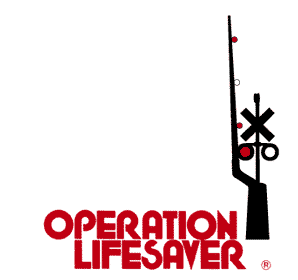Operation Lifesaver
Operation Lifesaver is the largest rail safety organization in the United States.[1] It was founded by the Union Pacific Railroad in the early 1970s.[2]

History
In 1972, the Idaho State Highway Patrol, then-Governor Cecil Andrus and the Union Pacific Railroad mounted campaign to promote "Stop, Look and Listen" safety at highway-rail grade crossings. The initial teams spoke to civic groups, school groups, school bus and truck drivers. Idaho experienced a 43% reduction in fatalities that first year.[3]
Operation Lifesaver has authorized volunteer speakers and trained instructors who provide free rail safety education programs across the U.S. and abroad. They give free presentations to school groups, driver education classes, community members, professional drivers, law enforcement officers, and emergency responders. Their programs are co-sponsored by federal, state and local government agencies, highway safety organizations and America's railroad systems. Operation Lifesaver, Inc. Who We Are. 7 February 2020. 7 February 2020. <https://oli.org/about-us/who-we-are>.
Campaigns
In 2006, Operation Lifesaver requested that Disney edit a scene of the Pixar film Cars in which the character of Lightning McQueen races a train to a grade crossing while the crossing lights are flashing. Disney/Pixar has removed the scene in question from theater showings but the DVD release of the movie still includes the scene.
On October 14, 2016, Operation Lifesaver requested via a Facebook post that Hollister Co. remove advertisements from their website showing teenagers walking on railroad tracks. Hollister removed the advertisements five days later on October 19.
In September 2017, Operation Lifesaver, Inc. spearheaded the observance of Rail Safety Week across the U.S. to raise awareness of the need for caution near railroad tracks and property.[4] In 2018, Operation Lifesaver Canada, which had been holding rail safety week observances for years, aligned its Rail Safety Week dates to coincide with the U.S. observance.
Criticism
Operation Lifesaver has been criticized for its strong ties to the railroad industry and the group's skew toward the railroad industry. The industry has reduced its support of the group’s efforts by providing fewer workers to help spread the group’s safety message. The group has also been criticized for not doing enough to support pedestrian railroad safety in the United States.[5]
Images
 WAMX #4020 with an Operation Lifesaver Kansas sticker.
WAMX #4020 with an Operation Lifesaver Kansas sticker.
 BNSF Manitoba Caboose (BN 12580) with Operation Lifesaver Canada paint scheme.
BNSF Manitoba Caboose (BN 12580) with Operation Lifesaver Canada paint scheme.
References
- "Safety Group Tied to Industry". New York Times. 14 November 2005. Retrieved 19 August 2014.
Operation Lifesaver is the nation's largest and most influential rail-safety group, but documents show that the organization is tightly bound to the railroad industry, and its critics, including many accident victims, say it inoculates railroads against liability in grade-crossing collisions
- Bogdanich, Walt; Jenny Nordberg (23 January 2005). "Highway Agency Disavows Claims by Rail Safety Group". New York Times. Retrieved 21 August 2014.
Operation Lifesaver, a nonprofit association co-founded three decades ago by Union Pacific, has denied having a pro-railroad agenda.
- "Statement of Gerri L. Hall, President, Operation Lifesaver, Inc". Federal Document Clearing House. 29 April 1998. Archived from the original on 21 September 2014. Retrieved 19 August 2014.
- "Railroads, Operation Lifesaver mark national Rail Safety Week".
- Frankel, Todd. "Rail safety group shrinks as danger grows". St. Louis Dispatch. Retrieved 16 July 2017.